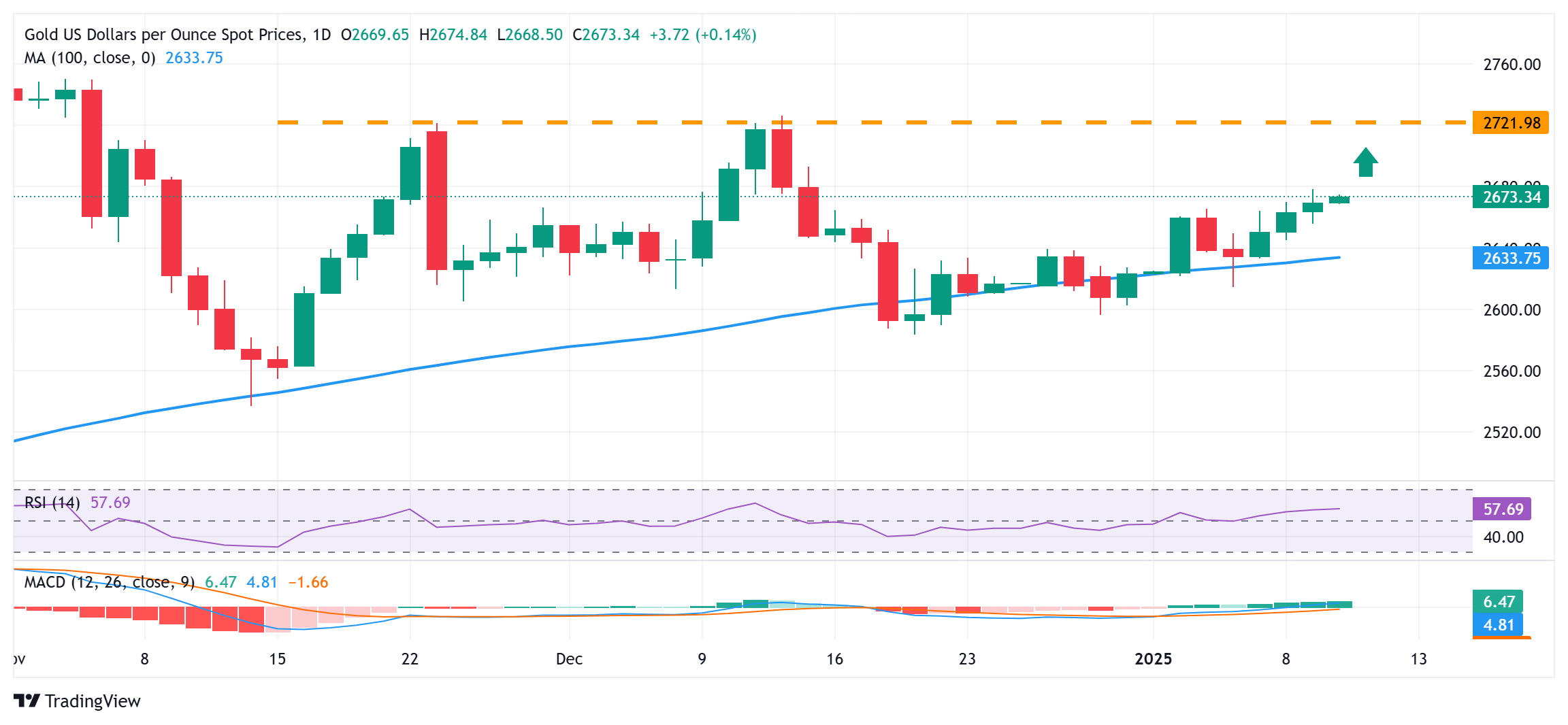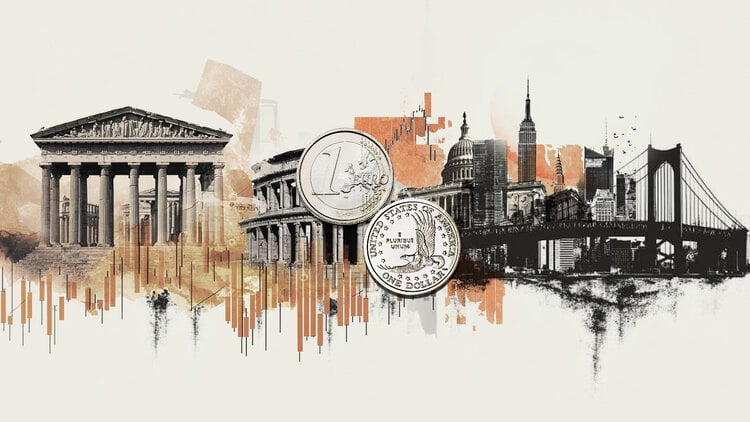- Gold price attracts buyers for the fourth consecutive day on Friday amid some safe haven flows.
- The Fed’s hawkish stance, high US bond yields and a bullish USD should limit gains.
- Traders could also choose to wait for the release of the key US NFP report later this Friday.
The price of Gold (XAU/USD) is trading with a positive bias for the fourth consecutive day on Friday and currently sits just below a near four-week high reached the previous day. Uncertainty surrounding US President-elect Donald Trump’s proposed tariffs, along with geopolitical risks, continues to weigh on investor sentiment and underpin safe-haven bullion. Furthermore, expectations that Trump’s expansionary policies will boost inflation turn out to be another factor benefiting the precious metal’s status as a hedge against rising prices.
That said, prospects for slower interest rate cuts by the Federal Reserve (Fed) continue to support elevated US Treasury yields and help the US Dollar (USD) remain stable near a maximum of two years. This, in turn, could act as a headwind for the non-yielding Gold price and limit any further gains. Traders also seem reluctant, choosing to wait for the release of the US Non-Farm Payrolls (NFP) report later in the US session. However, the XAU/USD pair remains on track to post gains for the second consecutive week.
Gold price continues to benefit from concerns over Trump’s tariff plans and geopolitical risks
- CNN reported Wednesday that US President-elect Donald Trump is considering declaring a national economic emergency to provide legal justification for universal tariffs on allies and adversaries.
- Ukrainian forces launched a new surprise offensive at Kursk, inside Russia, on August 6 and were reported to have advanced in three waves using company-sized assaults backed by armored vehicles.
- The Israel Defense Forces declared that the commander of Hamas’ Sabra battalion in Gaza City, his deputy and two commanders of the elite Nukhba company were killed in a series of airstrikes last week.
- The Federal Reserve took a tougher stance in December, projecting just two quarter-point rate cuts in 2025 amid still elevated inflation in the world’s largest economy.
- Boston Fed President Susan Collins said Thursday that the economy is on a gradual and uneven path toward the 2% inflation target and that the current outlook requires a patient approach to rate cuts.
- Philadelphia Fed President Patrick Harker noted that the central bank is expected to cut rates further, but explained that the path will depend on data and that it is taking longer to bring inflation back to 2%.
- Kansas Fed President Jeffrey Schmid noted that inflation is moving toward target, growth is showing momentum and the labor market remains healthy. Any further rate cuts should be gradual and data-driven.
- Fed Board of Governors member Michelle Bowman said the current policy stance may not be as restrictive as others may see it and that pent-up demand after the election could pose inflationary risks.
- Trump’s policies are expected to further stoke inflation and force the Fed to slow the pace of rate cuts this year, keeping US Treasury yields near multi-year highs. months reached last week.
- Traders now await the release of the US Nonfarm Payrolls (NFP) report, which is expected to show that the economy added 160,000 jobs in December and that the unemployment rate remained stable at 4.2%.
The price of Gold could now aim to recover the round figure of $2,700 amid a bullish technical environment
From a technical perspective, this week’s break through the $2,665 horizontal resistance was seen as a new trigger for bullish traders. Since the oscillators on the daily chart have just started to gain positive traction, Gold price seems poised to rally further to the intermediate hurdle of $2,681-$2,683 and then aim to reclaim the $2,700 mark.
On the other hand, declines towards the overnight low around the $2,655 area could be seen as a buying opportunity. This is followed by support near the $2,635 region and the weekly low, around the $2,615-$2,614 area touched on Monday, and the $2,600 confluence. The latter comprises the 100-day exponential moving average (EMA) and a short-term ascending trend line extending from the November monthly low, which if broken decisively will shift the bias in favor of bearish traders.
Gold FAQs
Gold has played a fundamental role in human history, as it has been widely used as a store of value and medium of exchange. Today, apart from its brilliance and use for jewelry, the precious metal is considered a safe-haven asset, meaning it is considered a good investment in turbulent times. Gold is also considered a hedge against inflation and currency depreciation, since it does not depend on any specific issuer or government.
Central banks are the largest holders of Gold. In their aim to support their currencies in turbulent times, central banks tend to diversify their reserves and purchase Gold to improve the perception of strength of the economy and currency. High Gold reserves can be a source of confidence for the solvency of a country. Central banks added 1,136 tons of gold worth about $70 billion to their reserves in 2022, according to data from the World Gold Council. This is the largest annual purchase since records exist. Central banks in emerging economies such as China, India and Türkiye are rapidly increasing their gold reserves.
Gold has an inverse correlation with the US Dollar and US Treasuries, which are the main reserve and safe haven assets. When the Dollar depreciates, the price of Gold tends to rise, allowing investors and central banks to diversify their assets in turbulent times. Gold is also inversely correlated with risk assets. A rally in the stock market tends to weaken the price of Gold, while sell-offs in riskier markets tend to favor the precious metal.
The price of Gold can move due to a wide range of factors. Geopolitical instability or fear of a deep recession can cause the price of Gold to rise rapidly due to its status as a safe haven asset. As a non-yielding asset, the price of Gold tends to rise when interest rates fall, while rising money prices tend to weigh down the yellow metal. Still, most of the moves depend on how the US Dollar (USD) performs, as the asset is traded in dollars (XAU/USD). A strong Dollar tends to keep the price of Gold in check, while a weaker Dollar is likely to push up Gold prices.
Source: Fx Street
I am Joshua Winder, a senior-level journalist and editor at World Stock Market. I specialize in covering news related to the stock market and economic trends. With more than 8 years of experience in this field, I have become an expert in financial reporting.








